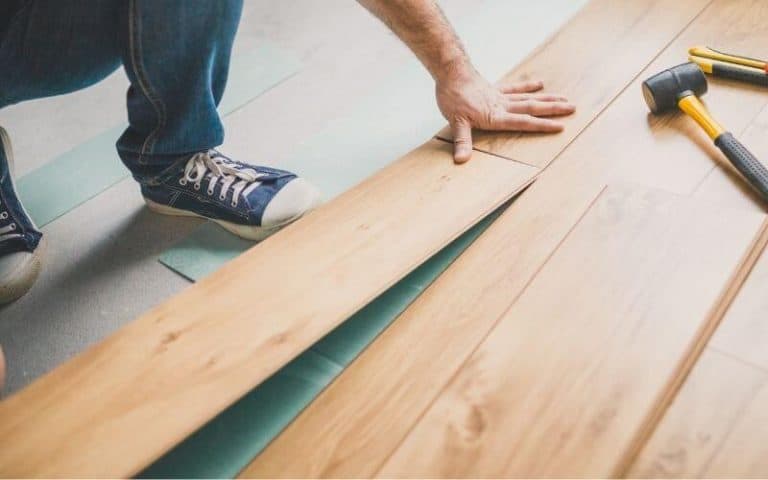Ever renovated a room and wondered if your new floating floor could handle the weight of your beloved appliances? You’re not alone! Floating floors have become increasingly popular due to their ease of installation and stylish appearance. But can they handle the demands of heavy appliances like washing machines and refrigerators?

Image: www.stkittsvilla.com
This article will delve into the world of floating floors, exploring their compatibility with appliances. We’ll dissect the pros and cons of placing appliances on these innovative flooring solutions, offering practical tips to ensure both your appliances and your floor remain in perfect harmony.
Understanding Floating Floors
Before we dive into appliances, let’s clarify what we mean by “floating floor.” These are essentially engineered wood floors, laminate floors, or luxury vinyl planks (LVP) that are installed without being directly attached to the subfloor. They “float” on a layer of underlayment, creating a cushioned and sound-dampening system.
This floating installation method is popular for several reasons:
- Ease of Installation: No need for nails or glue, making it a DIY-friendly option.
- Cost-Effective: Generally more affordable than traditional hardwood floors.
- Sound Absorption: Reduces noise transmission between floors, creating a quieter living space.
- Versatility: Available in a wide range of styles and textures to match diverse design aesthetics.
What Makes Floating Floors Tick?
- Underlayment: This is the hidden hero of the floating floor system. It’s a layer of material placed directly on the subfloor, providing a cushion, sound insulation, and a smooth surface for the floating floor planks to lay on. It comes in various materials like foam, cork, and even recycled rubber.
- Click-Lock System: Most floating floor planks use a clever click-lock system to interlock them together. This eliminates the need for glue and creates a strong, stable surface.
Appliances and Floating Floors: A Complicated Relationship
Now, let’s address the elephant in the room – can you actually put appliances on a floating floor? The answer isn’t a simple yes or no. It depends on several factors:
- The Appliance: The weight and size of the appliance are key considerations. A compact washing machine will likely pose less of a risk than a heavy, top-of-the-line refrigerator.
- The Floor Type: High-quality floating floors made from durable materials like thick laminate or engineered wood are better suited for appliance weight than thin options.
- The Installation: A properly installed floating floor with sufficient underlayment and a sturdy subfloor can better withstand the pressures of heavy appliances.

Image: floorcarekits.com
Potential Issues:
- Floor Sagging: A poorly installed floor or an appliance exceeding the weight limit can lead to sagging, causing an uneven surface and potential damage to the floor.
- Click-Lock System Failure: The constant pressure of a heavy appliance might eventually weaken the click-lock connections, leading to gaps or a loose floor.
- Underlayment Compression: The underlayment can compress under prolonged heavy weight, diminishing its effectiveness over time.
Taking Action: Building a Stable Base
Don’t despair if you love the look of your floating floor and those appliances are crucial for your daily life. Take proactive steps to ensure their compatibility:
- Choose the Right Floor: Opt for durable floating floors like high-density laminate, thicker engineered wood, or LVP with a wear layer designed to withstand heavier loads.
- Reinforce the Subfloor: Ensure your subfloor is strong and even before installing the floating floor. If necessary, consider adding plywood sheets for extra support.
- Proper Underlayment: Select a high-quality underlayment that offers a good balance of cushioning and strength. Consider options with a higher density, foam, or cork for added resilience.
- Distribute the Weight: If possible, spread the appliance’s weight across a wider area by placing it on a sturdy platform or base. This will reduce the pressure on a single point of the floor.
- Seek Professional Advice: Consult a flooring expert for guidance. They can assess your specific situation and recommend the best course of action.
Beyond the Basics: Considerations for Specific Appliances
- Washing Machines: The vibration from a washing machine can potentially affect a floating floor. Consider using a rubber mat or a dedicated machine base to minimize movement and noise transmission.
- Refrigerators: While refrigerators are typically heavy, they are often placed on level ground without significant vibration. Ensure the floor can support the weight, and use leveling feet to ensure stability.
- Dishwashers: These appliances generally have a lower weight and pose less of a risk. Still, verifying the floor’s ability to support them is always a good practice.
Can You Put Appliances On A Floating Floor
Final Thoughts
Placing appliances on floating floors can be achieved successfully with careful planning and a bit of extra effort. Remember, it’s not a one-size-fits-all situation. Evaluate your floor, your appliances, and consult with professionals if needed. By following the right steps, you can enjoy the beauty and practicality of floating floors without sacrificing the functionality of your essential appliances.
Remember, your home is your sanctuary, and creating a space that reflects your style and needs is a rewarding process. Don’t hesitate to ask questions, seek expert advice, and ultimately make choices that make your home both beautiful and functional.





